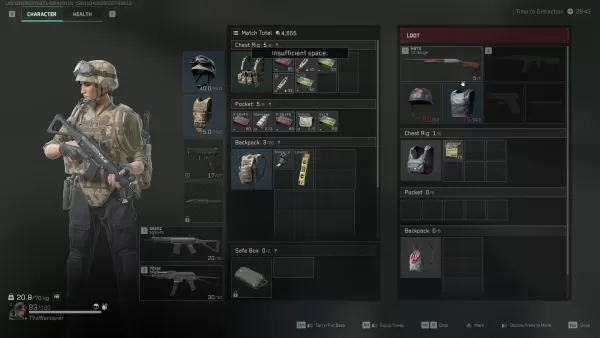Operations mode in Delta Force, also known as Hazard Operations or Extraction mode, is the core of the game's adrenaline-pumping action. Whether you call it Operations or "raiding," the objective remains consistent—parachute into the map, gather valuable gear, and escape with your life before other players or AI enemies eliminate you. The twist, akin to other extraction shooters, is that everything you carry into the match is at risk; if you die, you lose it all.
This guide delves deeper than mere survival strategies. Here, you'll discover the mechanics of Operations mode from beginning to end, learning how to manage the tempo of your run, handle your equipment effectively, and make strategic decisions that increase your long-term value. If you're seeking basic survival tips for Operations mode, please refer to our dedicated blog post on the topic.
Whether you're playing solo or with a squad, understanding the system is crucial for playing more intelligently, rather than just harder.
What Operations Mode Actually Is
Delta Force's Operations mode is a dynamic PvPvE environment where no two matches are the same. You, along with up to two other players, enter a map teeming with AI soldiers, scattered loot, and rival teams. Your mission is to collect as much loot as possible and extract safely before being taken out.
Unlike traditional shooter modes, there's no score to chase. What you manage to extract becomes part of your permanent inventory. Conversely, dying means losing everything you're carrying, except for items safely stored in your Safe Box. This risk-and-reward dynamic is what makes Operations mode so thrilling—even if you're just snatching medical supplies and making a stealthy getaway.
Loadout Planning and Inventory Control
Your success begins before you even set foot on the map—it starts with selecting the optimal loadout for your strategy. Each match requires an entry fee, so your loadout choices are critical. Essentials like a helmet, armor, chest rig, and backpack are mandatory; you can't deploy without them. However, the additional items you bring can significantly alter your approach to the game.

Extraction zones are typically fixed, though some maps feature dynamic elements like elevators or enemy-controlled checkpoints. Always have an exit strategy planned before you venture deep into looting.
Loot Smarter, Not Harder
Each item in Operations mode has a sell value, but not all are worth the risk. Early in your journey, focus on acquiring healing items, weapon attachments, and rare electronics—these are compact, valuable, and easy to secure in your Safe Box if necessary.
While heavy weapons and armor may seem appealing, they can encumber you and occupy valuable space. Only carry them if you're confident about extracting or if you're close to your exit with nothing to lose.
A useful tip for beginners is to steer clear of major loot spots during the initial minutes. Allow other teams to engage in combat, then scavenge what they leave behind. If you're playing solo, focus on looting the outskirts of the map and revisit later. You might be surprised at the quality of items abandoned after a fierce team battle.
Picking the Right Operative
Your choice of Operative shapes your gameplay style in Operations mode. Not all Operators are suited for stealth or loot-centric play, so select one that aligns with your objectives.
Luna and Hackclaw excel in gathering intelligence and maintaining mobility. Luna's shock arrows can tag enemies and disrupt advances, while Hackclaw's silent movement and stealthy knife takedowns are perfect for covert operations. Stinger, with his healing capabilities, is ideal for team plays, particularly when supporting more aggressive teammates.
Avoid Operatives with conspicuous or flashy abilities unless your goal is to engage in combat. Characters like D-Wolf are entertaining, but they draw too much attention in a mode where staying undetected often yields better outcomes.
Fight When It Matters
In Operations mode, choosing your battles wisely is more crucial than winning them. While PvP kills can provide gear and XP, they also slow you down and attract unwanted attention. Only engage when it's advantageous or necessary.
If you find yourself in a firefight, keep moving and aim to end it quickly. Utilize your abilities strategically—Luna's detection arrow can reveal enemies behind cover, and Stinger's smoke can provide cover to heal or retreat.
Remember, you can loot the fallen later. If two teams are clashing, hang back and let them weaken each other. Third-partying is risky, but it's an effective method to acquire gear without needing to outgun everyone yourself.
Making the Most of Each Match
Every raid is an opportunity to accumulate value, hone your skills, or learn something new. Don't fret over a failed run; use it to refine your strategy for future attempts.
Conserve your credits during losing streaks and play more strategically when you're on a roll. Prioritize upgrading your Safe Box early, experiment with different Operator configurations, and explore the maps to discover optimal loot paths.
Over time, your focus will shift from merely surviving to optimizing your gameplay. That's when Operations mode truly becomes enjoyable.
Delta Force's Operations mode is more than just a simple loot-and-run scenario. It's a game of risk, strategic planning, and intelligent decision-making. Assemble your loadout with intent, loot judiciously, and know when to engage or retreat. Remember, every defeat is just a part of the journey that makes your first significant victory even sweeter.
For the best gaming experience, play Delta Force on PC using BlueStacks. Enjoy faster load times, precise controls, and easier gear management. It's the optimal way to stay competitive while mastering the game.















